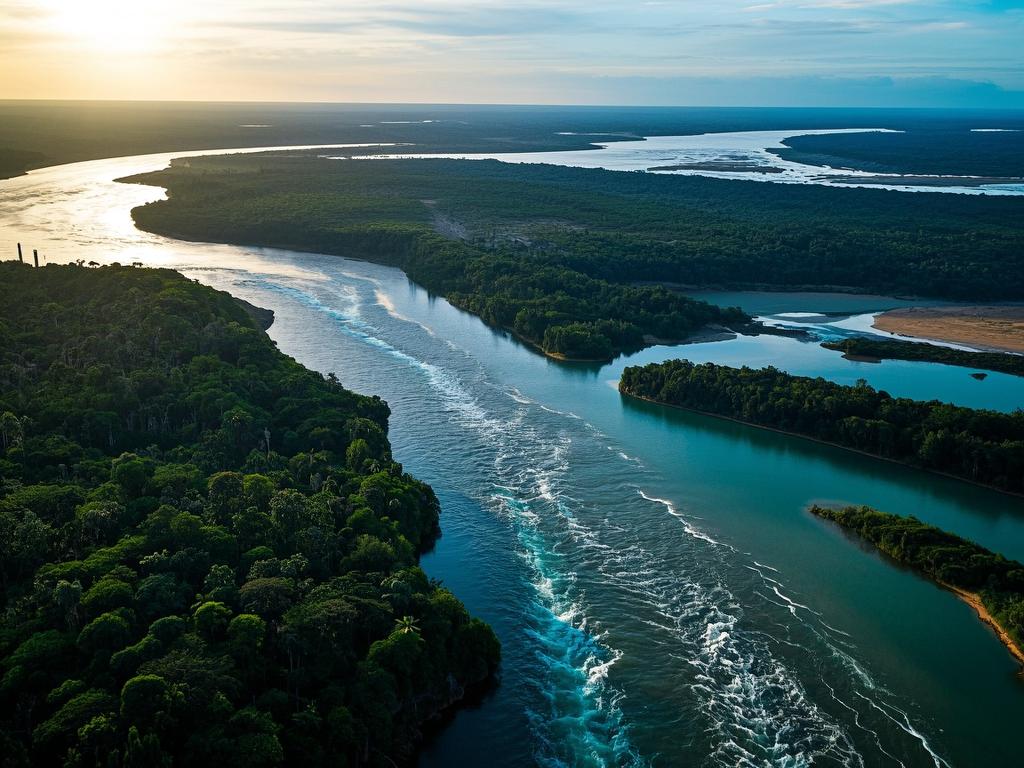
# The Enormous Rivers of South America: Lifeblood of a Continent Imperiled
The vast expanse of South America is crisscrossed by some of the most magnificent rivers on Earth. These waterways, like the Amazon, Orinoco, and Paraguay-Paraná, are not just geographical features; they are the lifeblood of a continent, sustaining countless species and human civilizations. However, in the face of climate change, deforestation, and unregulated development, these once-mighty rivers are under unprecedented threat.
Let's start with the Amazon, the undisputed king of South American rivers. Stretching across nine countries, it discharges more water into the ocean than the next eight largest rivers combined. This gargantuan river system is home to an estimated 10% of the world's known species, making it a biodiversity hotspot of unparalleled importance. From the elusive jaguar prowling the rainforest floor to the colorful macaws soaring above the canopy, the Amazon is a living testament to the wonders of nature.
But here's the catch: the Amazon is in big trouble. Deforestation, primarily driven by agriculture and logging, is rapidly shrinking the rainforest that the river depends on. Every year, thousands of square kilometers of forest are cleared, disrupting the delicate balance of the ecosystem and threatening the survival of countless species. According to recent studies, if deforestation rates continue at their current pace, the Amazon could reach a tipping point by 2030, triggering a catastrophic die-off of plants and animals and a significant reduction in rainfall across the region.
And it's not just the rainforest that's at risk. The Amazon's rivers are also being polluted at an alarming rate. Industrial waste, agricultural runoff, and oil spills are contaminating the water, making it unfit for human consumption and deadly for many aquatic species. A recent report by the environmental group Greenpeace found that some stretches of the Amazon are so polluted that they contain levels of mercury and other toxins that are hundreds of times higher than the safe limit.
The Orinoco, another major river in South America, is also facing a host of challenges. Originating in the Guiana Highlands of Venezuela, the Orinoco flows through a vast savannah landscape before emptying into the Atlantic Ocean. Like the Amazon, the Orinoco is home to a rich diversity of plant and animal life, including several endangered species such as the Orinoco crocodile and the giant otter.
However, the Orinoco is being increasingly exploited for its natural resources. Oil and gas exploration, hydroelectric dams, and mining operations are all taking a toll on the river and its surrounding ecosystem. The construction of dams, in particular, is having a significant impact on the river's flow and sediment transport, altering the habitats of fish and other aquatic species. A recent study by the World Wildlife Fund found that the proposed expansion of the Caroní River dam in Venezuela could displace thousands of people and have a devastating impact on the Orinoco's biodiversity.
The Paraguay-Paraná river system, which flows through Brazil, Paraguay, Argentina, and Uruguay, is also under threat. This river system is an important source of water for agriculture, industry, and human consumption, but it is being degraded by pollution, deforestation, and the construction of dams. The Itaipu Dam, one of the largest hydroelectric dams in the world, has had a significant impact on the flow and water quality of the Paraguay-Paraná river system, disrupting the migration patterns of fish and other aquatic species.
So, what can we do to save these precious rivers? The answer lies in a combination of conservation efforts, sustainable development, and political will. We need to protect the rainforests that the rivers depend on by implementing strict anti-deforestation laws and promoting sustainable land use practices. We also need to reduce pollution by improving waste management systems and cracking down on industrial and agricultural pollution.
In addition, we need to invest in renewable energy sources such as solar, wind, and hydroelectric power to reduce our reliance on fossil fuels and minimize the impact of energy production on the environment. And finally, we need to raise awareness about the importance of these rivers and the threats they face. By educating the public and inspiring action, we can create a groundswell of support for conservation and sustainable development.
As an ecologist, I am deeply concerned about the future of South America's rivers. These waterways are not just important for the environment; they are also essential for the economic and social development of the region. If we fail to act now, we risk losing these precious natural resources forever. So, let's all do our part to protect these magnificent rivers and ensure that they continue to flow for generations to come.
What are your thoughts on the future of South America's rivers? Do you have any ideas for how we can protect these precious waterways? Let's start a conversation and work together to make a difference!
In conclusion, the enormous rivers of South America are the lifeblood of a continent imperiled. From the Amazon to the Orinoco and the Paraguay-Paraná, these waterways are facing unprecedented threats from climate change, deforestation, and unregulated development. But there is still hope. By taking action now, we can protect these precious rivers and ensure that they continue to support the rich biodiversity and human civilizations that depend on them. So, let's all do our part to save these magnificent rivers and safeguard the future of South America.

